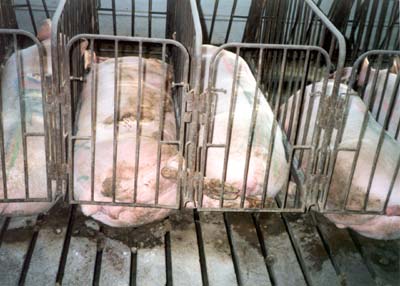Paul McCartney was once quoted as saying, ‘if slaughterhouses had glass walls, everyone would be a vegetarian.’ The French have moved one step closer to the idea with their parliament backing a draft bill to install CCTV cameras in all of the country’s 1000 abattoirs.
The bill must be passed by the French Senate in February before it can become law, and if successful, those caught inflicting unlawful cruelty on animals face up to one year in prison. This follows the publication of a parliamentary report in March which recommended introducing CCTV, amongst other measures, to ‘improve transparency and inadequate controls.’ Animal rights groups had previously released graphic videos of French abattoirs, showing extreme acts of violence towards animals including one video in which workers threw a lamb against a wall and hit sheep over the head.
This step, although small, is a progressive one for animal welfare in France. Video surveillance which is properly monitored ensures that slaughterhouse workers no longer feel they can act as if no one is watching.
In the UK around 43% of red meat slaughterhouses and 55% of white meat slaughterhouses had some form of CCTV in use for animal welfare purposes by 2013. This does not mean that abuse in UK abattoirs is non-existent however.

Proper use of CCTV could shed light on abuses in the processes of farming and slaughter (Image: Wikipedia Commons)
The campaign group Say Yes to Slaughterhouse CCTV investigates the treatment of animals inside UK abattoirs and found that voluntary CCTV that was not properly monitored by a third party was ineffective. At one abattoir that had already installed cameras they witnessed sheep being kicked in the face, thrown by their fleeces, legs and ears. Footage from other abattoirs recorded sheep’s throats being cut with blunt knives whilst fully conscious and cigarettes stubbed out on pigs faces.
The voluntary introduction of cameras is pointless if it is not effectively monitored and the footage used. For some abattoirs it is nothing more than an empty gesture, or the CCTV is mostly used as a security measure to prevent trespass and theft. Many slaughterhouses have shown that they are not sufficiently motivated to properly detect and deal with the abuse they film. However, properly used CCTV can be a positive step. Any move towards more transparency is always welcome, as evidenced by the example of Denmark.
Denmark operates perhaps some of the most transparent slaughterhouses in the world and are progressive in their animal welfare regulations. Danish Crown is the largest pork processor in Europe and holds tours of its slaughterhouses daily. It is one of Denmark’s most popular tourist attractions and has been visited by over 250,000 people since it opened in 2005. At their slaughterhouses pigs are gassed until unconscious rather than stunned with an electric bolt gun, and the presence of tourists acts as a control against unnecessary violence.
Footage from abattoirs recorded sheep’s throats being cut with blunt knives whilst fully conscious and cigarettes stubbed out on pigs’ faces
Whilst Danish animal welfare legislation is linked to EU Directives, it exceeds the requirements in many areas. There are also strict statutory requirements for the transport of animals, designed to ensure their comfort and protect them from injury and unnecessary suffering. In 2014 Denmark removed an exemption that allowed non-stunning (the animal is killed while conscious) for ritual slaughter. The Minister for Agriculture and Food Dan Jørgensen stated then that ‘animal rights come before religion’.
Denmark is not perfect however. 25,000 piglets a day still die in Danish factory farms. Half of all sows have open sores and 95% have their tails docked to prevent biting. This does not mean CCTV and more transparency won’t work; this means factory farming does not work.
Cameras work to reduce animal suffering in two ways. Firstly, they create a way to directly monitor and punish those who abuse animals in abattoirs. As long as they are sufficiently monitored they will both reduce abuse from occurring in the first place and catch those who continue to break animal welfare laws.
Secondly, creating footage of the processes of animal slaughter and increasing awareness of the violence of the industry will lead to increased public pressure to improve welfare. The disconnect between the food on our plate and the animal it came from is the only reason factory farming exists as it does.
This does not mean CCTV and more transparency won’t work; this means factory farming does not work.
The Danish system, for all its flaws, lets more people know where their pork came from, and as a result there is greater emphasis on animal welfare. While it is impossible for any system that kills animals for meat to be completely without suffering, reducing unnecessary violence and pain can only be a good thing.
More than 1 billion farm animals are slaughtered in the UK each year. Some schemes such as the RSPCA’s ‘Freedom Food’ has required CCTV in all live animal areas since 2011. The ‘Red Tractor’ scheme used by many meat wholesalers recommends that CCTV is used ‘to monitor the performance of staff at the point of stunning and slaughter.’ Most major food retailers (including Asda, the Co-operative, Iceland, Marks and Spencer, Morrisons, Sainsbury’s, Tesco, Lidl and Waitrose) insist upon the use of CCTV in supply chain slaughterhouses.
Compulsory, third-party monitored CCTV in UK abattoirs should be the next step. The Food Standards agency, along with a cross-party representation of over 200 MPs and the British Veterinary Association already support the introduction of mandatory CCTV but this needs to be effectively monitored and credible penalties introduced.
This would be progress, but there is still a great deal more that needs to be done to improve welfare in the animal agriculture industry. Improving the deaths of these animals is only the first step.


